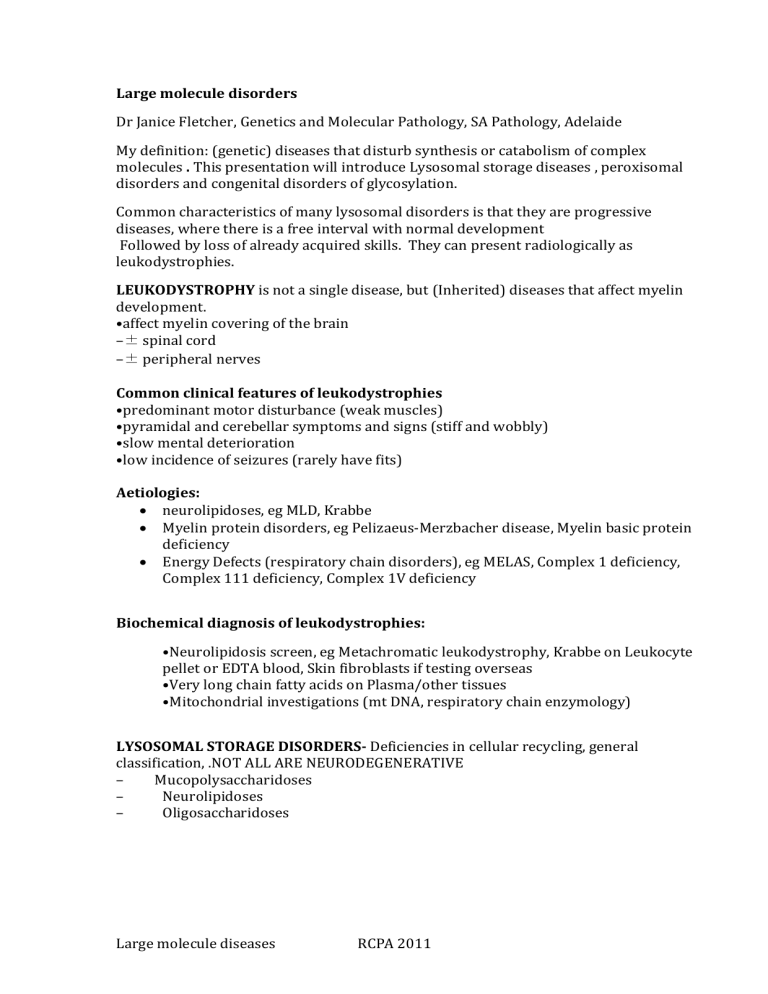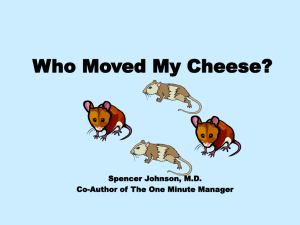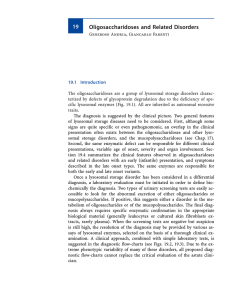Dr Janice Fletcher, Genetics and Molecular Pathology, SA Pathology, Adelaide

Large molecule disorders
Dr Janice Fletcher, Genetics and Molecular Pathology, SA Pathology, Adelaide
My definition: (genetic) diseases that disturb synthesis or catabolism of complex molecules . This presentation will introduce Lysosomal storage diseases , peroxisomal disorders and congenital disorders of glycosylation.
Common characteristics of many lysosomal disorders is that they are progressive diseases, where there is a free interval with normal development
Followed by loss of already acquired skills. They can present radiologically as leukodystrophies.
LEUKODYSTROPHY is not a single disease, but (Inherited) diseases that affect myelin development.
•affect myelin covering of the brain
– ± spinal cord
– ± peripheral nerves
Common clinical features of leukodystrophies
•predominant motor disturbance (weak muscles)
•pyramidal and cerebellar symptoms and signs (stiff and wobbly)
•slow mental deterioration
•low incidence of seizures (rarely have fits)
Aetiologies:
• neurolipidoses, eg MLD, Krabbe
• Myelin protein disorders, eg Pelizaeus-Merzbacher disease, Myelin basic protein deficiency
• Energy Defects (respiratory chain disorders), eg MELAS, Complex 1 deficiency,
Complex 111 deficiency, Complex 1V deficiency
Biochemical diagnosis of leukodystrophies:
•Neurolipidosis screen, eg Metachromatic leukodystrophy, Krabbe on Leukocyte pellet or EDTA blood, Skin fibroblasts if testing overseas
•Very long chain fatty acids on Plasma/other tissues
•Mitochondrial investigations (mt DNA, respiratory chain enzymology)
LYSOSOMAL STORAGE DISORDERS- Deficiencies in cellular recycling, general classification, .NOT ALL ARE NEURODEGENERATIVE
– Mucopolysaccharidoses
–
–
Neurolipidoses
Oligosaccharidoses
Large molecule diseases RCPA 2011
incidence of LSDs in Australia . Modification from Meikle 1999 (JAMA)
Commonest Neurolipidoses:
• Fabry - not neurodegenerative, •X-linked lysosomal storage disorder
Females can be affected despite normal enzyme levels
–Diagnostic challenges (supplementary investigations usually required – molecular, urine glycolipid profiling
•Presents with acropatasthesiae/renal involvement/cardiomyopathy/*premature stroke
• MLD – commonest leukodystrophy in childhood (can have psychiatric presentation in adulthood)
•Krabbe
•Tay sachs etc
Also think of lysosomal storage disorders in the following clinical setting:
•Hyperactivity/behavioural difficulties (Sanfilippo, Hunter)
•Coarse features
•Organomegaly
•Bony abnormalities/joint restriction
•Corneal clouding
•Recurrent otitis media/hearing loss
•Herniae in childhood
•Dementia/intellectual impairment
•Onset of spasticity
•Renal failure
•Cardiomyopathy
Large molecule diseases RCPA 2011
Techniques used in making a lysosomal storage disease diagnosis
• urine: Mucopolysaccharide electrophoresis , Oligosaccharide chromatography
Tetrasaccharide analysis for Pompe is a second tier/confirmatory test, (tandem mass spectrometry)
• “ White cell enzymes ” (bloods to Adelaide)
(Neurolipidosis screen + Batten enzymes) on leukocyte pellet
–Send frozen leukocyte pellet or 5 ml EDTA blood to arrive within 48 hours
–Alert lab to sample being sent, don’t consign Thursday/Friday
•Specific MPS enzymes on leukocytes
(where indicated on urine results or clinical presentation)
• Filter paper blood spots for alpha glucosidase (Pompe testing), WCE
• Specific mutation detection
• skin
•EM for storage
•enzyme confirmation in proband
•Tracer studies
•enzyme assays/tracer studies in parents in preparation for prenatal diagnosis
–Exclude variant biochemical phenotype in carriers in this family
•Niemann Pick C
Pseudo-deficiencies (MLD, Krabbe)
PEROXISOMOPATHIES
•Elevated very long chain fatty acid the hallmark
–Single enzyme deficiencies
–Peroxisomal biogenesis disorders
–Transport defects
•Further definition through
–Plasmalogen analysis
–PEX genes
–Enzyme assays
Zellweger spectrum/ peroxisomal biogenesis defects (some single enzyme disease)
–neonatal onset,
–often dysmorphic
• Adrenoleukodystrophy
•first described by Schilder in 1913
•first complete study Siemerling and Creutzfeldt in 1923
•X-linked inheritance observed 1963 affects 1 in 33,000 Australasian males (Kirk 1997)
–Spectrum of clinical phenotypes may be seen in a single family
• Probably a true oligogenic disease
• 1 in 5 boys (< 15 years) with Addison’s disease have ALD
•Biochemical Hallmark: Elevated VLCFA (Igarashi et al 1976)
•ALD protein (transporter) cloned 1993: MOST PRIVATE MUTATIONS
Large molecule diseases RCPA 2011
CONGENITAL DISORDERS OF GLYCOSYLATION
•Multi-system disorders
•Serum the preferred sample for transferrin isoform testing (screening test)
•Transferrin isoforms can present false negative on fetal blood/first month of life due to fetal isoforms
–Prenatal diagnosis failure (Clayton)
•Rare cases can have normal screening tests
Defects in protein N-glycosylation, CDG1a – an n-linked glycosylation defect
•Abnormal morphology (glycoproteins are important in embryogenesis)
–hypoplasia of the cerebellar vermis
–fat pads, inverted nipples
–Hypotonia
–Strabismus
–Failure to thrive
–Cardiac disease
•Coagulopathy
•liver disease
•delayed puberty
Peripheral neuropathy
CGG 1b : Phosphomannomutase isomerase deficiency
–Protein losing enteropathy and liver disease
–Hypoglycemia and hyperinsulinemia
–Neurologically normal
–Therapy with mannose
•CDG types 1c-j
•CDG types 2a-e
•CDG x
Defects in protein O-glycosylation eg, Muscle Eye Brain disease, Walker Warburg syndrome (absence of glycosylation of alpha-dystroglycan )
Defects in glycosphingolipid and glycosylphosphatidylinositol anchor
Defects in multiple glycosylation and other pathways
Latest details and classification http://www.euroglycanet.org
SUMMARY Insist on clinical details where these disease are suspected.
The choice of tests is dependent on the clinical features and a hierarchy of tests based on clinical indications will produce the most efficient diagnostic route. These are rare diseases. If in doubt “phone a friend”. Clinical details from requesting clinicians enable expert labs to recognise clues to aetiology.
Large molecule diseases RCPA 2011








